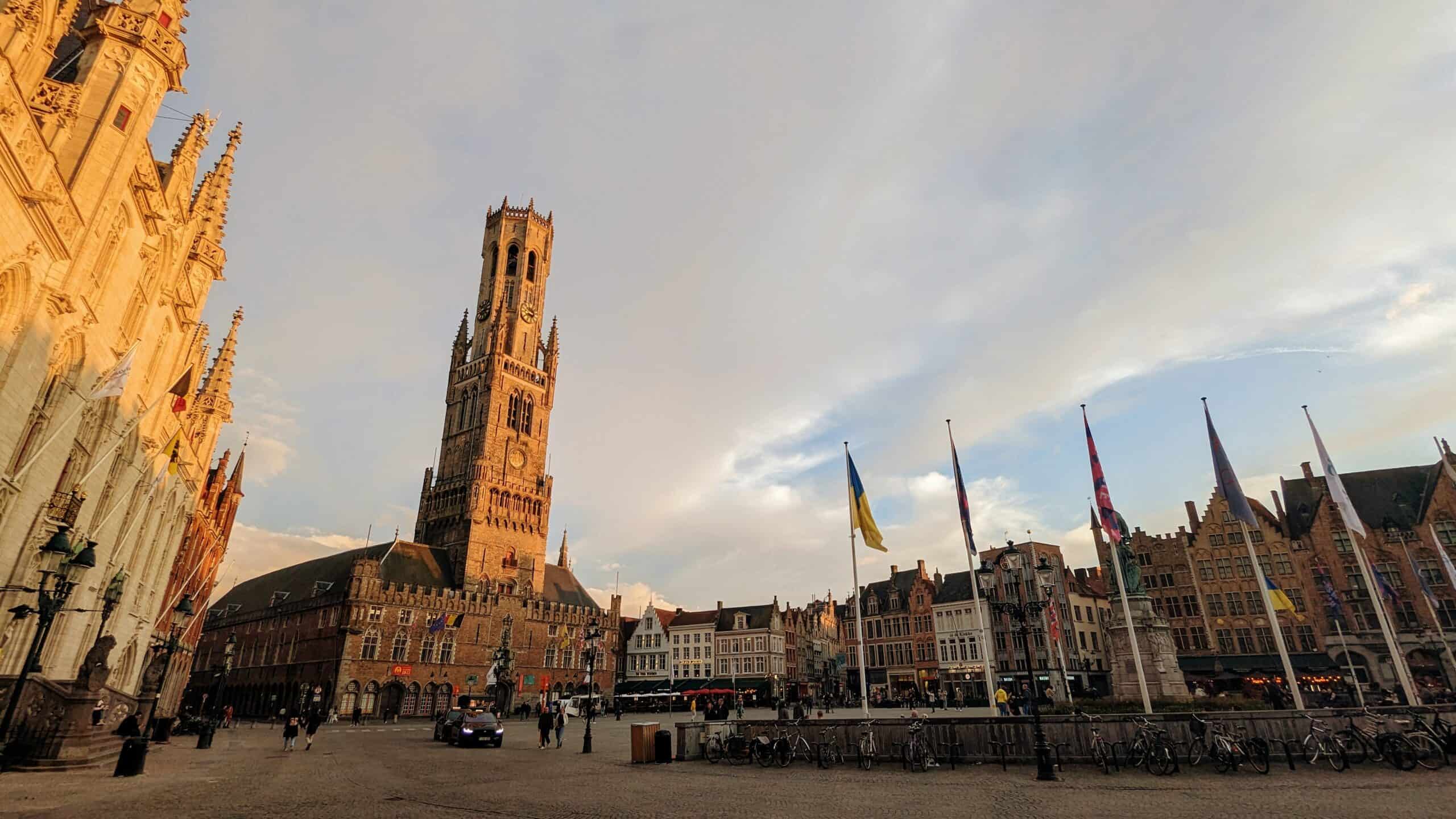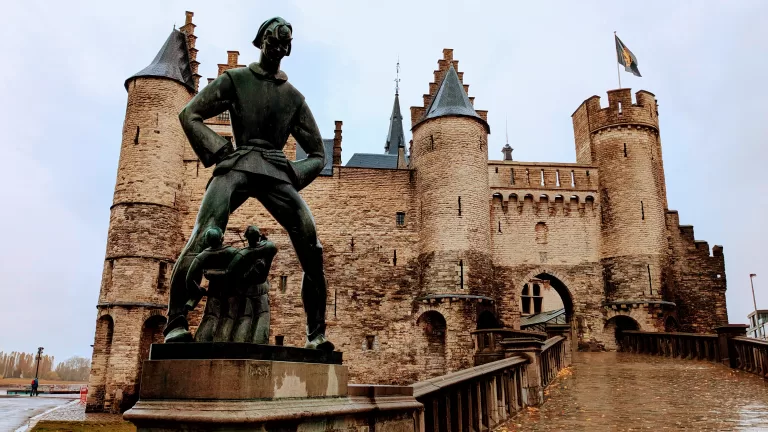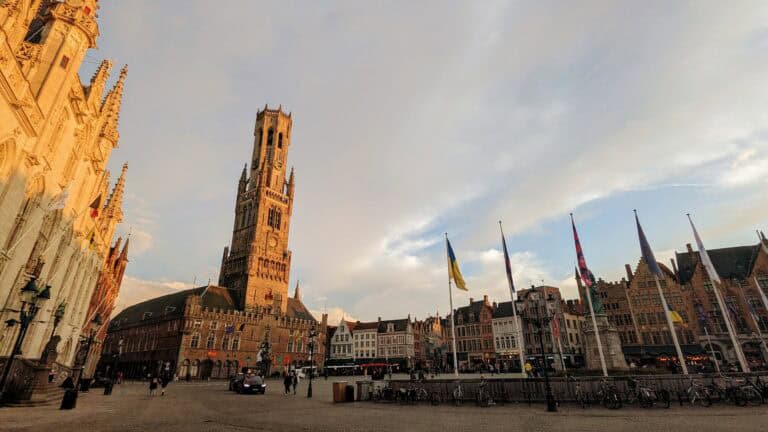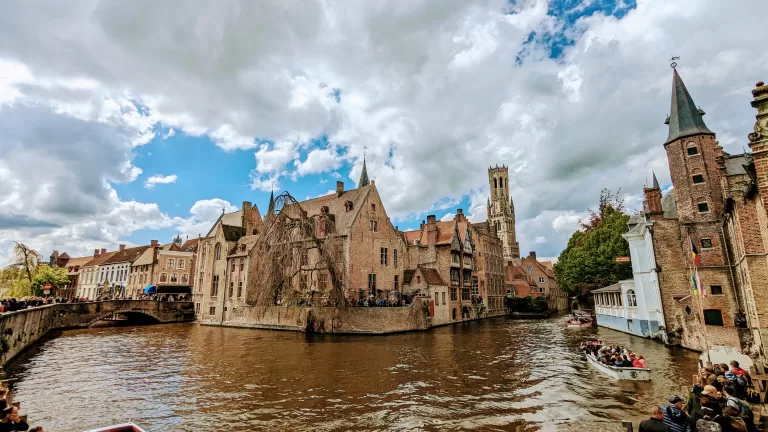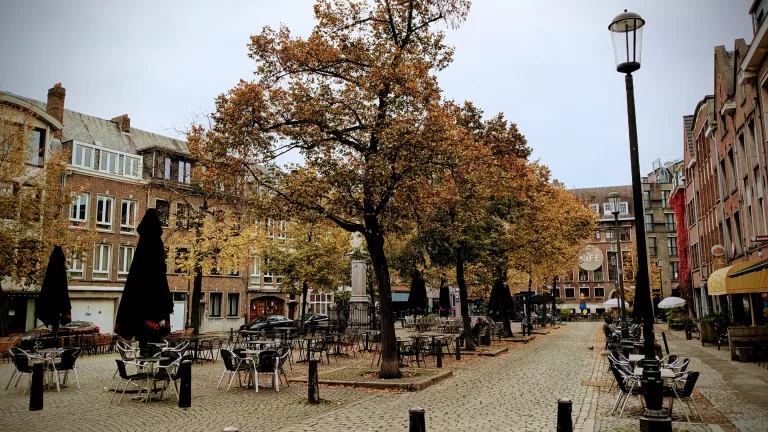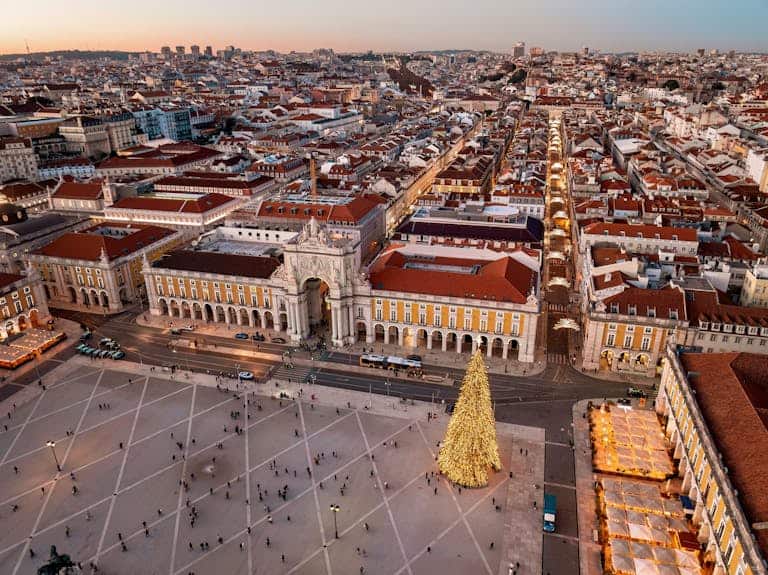Bruges travel guide: practical information on how to visit
Imagine sipping Belgian beer by a canal, surrounded by gingerbread-house-like buildings. That’s Bruges!
If you’re planning a short break (or a longer, slow-paced escape), this guide gives you our practical advice: how long to stay, where to base yourself, the best ways to get there and get around, plus a handful of local tips that actually save time and money.
Check out our Bruges travel guide for all you need to know about visiting Bruges. And, don’t miss our guide on the best things to do in Bruges as well as the best places to stay – or, you can see all our content on travelling to Belgium here.
How long should you stay in Bruges?
We’d say 2-3 days is ideal for Bruges. It’s enough time to see the main sights, sample the local food, and soak up the atmosphere without feeling rushed. If you like history or art, add an extra day to see a few museums and churches. See our guide to 29 unmissable things to do in Bruges to help you decide.
You could also stay longer and add on a few day trips, for example to the more modern town of Ghent or for a walk around the countryside surrounding Bruges.
Bars and restaurants are open in the evening, but we found it surprisingly quiet. There’s still a few places open to eat and drink, but it didn’t have the nightlife we were expecting (or Brussels has).
Where should you stay in Bruges?
For first-timers, we recommend staying in the historic city centre. It’s a bit pricier, but the convenience is worth it. You’ll be steps away from the main attractions and can easily pop back to your hotel for a midday rest (you’ll appreciate this after a morning of sightseeing).
If you’re on a budget or prefer a quieter atmosphere, consider staying just outside the centre in areas like Sint-Gillis or Sint-Andries. These neighbourhoods are still within walking distance of the main sights but offer a more local vibe.
One thing to keep in mind: Bruges gets busy with day-trippers. Staying overnight means you get to experience the city’s magical atmosphere in the early morning and late evening when the crowds have gone. There’s nothing quite like an evening stroll along the canals when they’re all lit up!
Read our full guide on where to stay in Bruges.
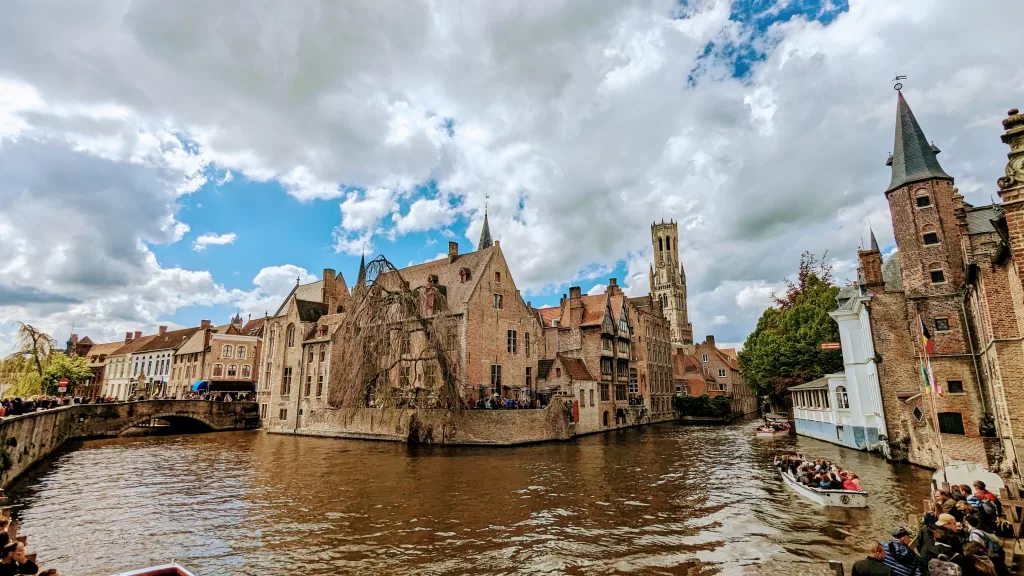
How do you get to Bruges?
Getting to Bruges is easy, especially if you’re coming from elsewhere in Europe.
By train
Bruges has a well-connected train station, making it easy to reach from other Belgian cities and beyond. If you’re coming from Brussels, it’s just an hour away. From Ghent, it’s even quicker at about 30 minutes. There are also trains to Amsterdam, which take about 3 hours, normally changing at Antwerp or Brussels.
Once you arrive at Bruges station, getting to the centre is simple. We’d recommend walking – it’s about 20 minutes to the city centre and it’s a nice walk through Bruges.
Or, you can take a bus (numbers 1, 6, 11, or 16) to the Markt (main square), or grab a taxi from outside the station.
By air
Brussels Airport (BRU) is the main international option and has frequent rail connections to Bruges (which takes about 1 hour depending on the service and transfer).
If you want a closer airport, Ostend–Bruges (OST) is much nearer. It’s about a 15-minute train from Ostend to Bruges, though flight options are more limited.
If you’re coming from the UK, then the Eurostar can be faster and cheaper than flying. It takes about 2 – 2.5 hours to go from London to Brussels, then you’ll need to get a connecting train to Bruges (around 1 hour). The connection is easy, as it’s the same train station (just changing platforms) and you can normally make it in as little as 15 minutes.
By car
Driving to Bruges is straightforward, but parking in the city centre can be a bit of a headache. We’d suggest using one of the park-and-ride facilities on the outskirts of town. The most popular options are Boogschutterslaan, Coiseaukaai, Waggelwater and Steenbrugge. All four of these options are free, and it’s less stressful than trying to find parking in the old town.
Remember, Bruges is a small city with narrow streets. Once you’re there, you won’t need a car. In fact, many parts of the centre are car-free, which adds to its charm.
How do you get around Bruges?
One of the joys of Bruges is how easy it is to get around.
Cycling and walking
Bruges is made for wandering. The compact city centre is perfect for exploring on foot. You can easily walk from one side to the other in about 30 minutes.
If you want to cover more ground, hire a bike. It’s a great way to venture a bit further afield, but bear in mind you may not need it for Bruges town centre – it gets busy and you’ll be dodging tourists, and it’s so compact you won’t need it. There are plenty of rental shops around town. Just be careful on the cobblestones when it’s wet!
Public transport
Bruges has a good bus network, but we rarely used it. The city is so walkable that you probably won’t need to. If you do decide to use the bus, you can buy tickets on board, at machines at the bus stop, on the De Lijn app, or at newsagents. A single trip costs €3, or you can get a 10-journey card for €21.
Taxis and car shares
Taxis are available, but they can be pricey for short trips. You’ll find taxi ranks at the train station and in the Markt. Uber isn’t available in Bruges, but there’s a local alternative called Victor Cab that works in a similar way.
Canal tours
While not strictly transport, canal tours are a great way to see the city from a different perspective. They last about 30 minutes and give you a good overview of Bruges’ layout and history. There’s various points around Bruges to buy a ticket and get on board – you’ll see them as you wander round.
Schedules vary by season and some operators scale back in deep winter, so check departure points and times on the day
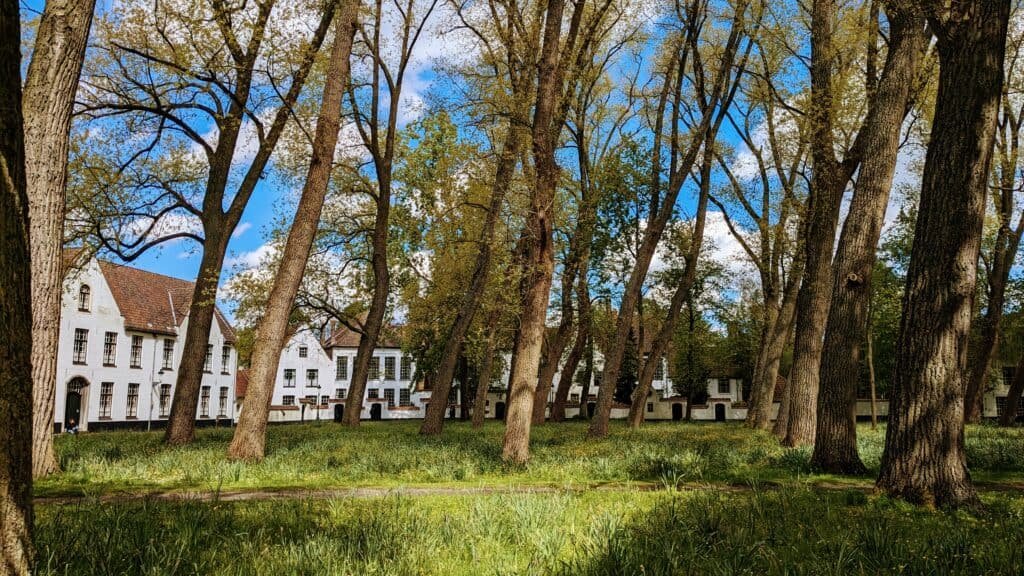
When should you go to Bruges?
Bruges is lovely year-round, but each season has its charms.
Spring (March to May): This is our favourite time to visit. The weather is mild, the crowds are smaller than in summer, and the city’s gardens are in bloom.
Summer (June to August): It’s peak tourist season, so expect crowds. The weather is great for outdoor activities and wandering Bruges’ lanes, and there are lots of festivals. Prices are a lot higher, so book early.
Autumn (September to November): Another great time to visit. The crowds thin out, and the autumn colours in the parks are stunning. Bruges Beer Festival (Brugs Bierfestival) and the Kookeet food festival normally take place in September too.
Winter (December to February): It can be chilly, but Bruges transforms into a winter wonderland. There’s Christmas markets, and you might even see the canals freeze over. Just pack warm clothes!
What are the best things to do in Bruges?
Bruges is packed with things to do, but here are some must-dos:
- Get lost! Wander Bruges many cute streets and canals
- Climb the Belfry: It’s 366 steps, but the view is worth it. Go early to beat the crowds.
- Take a canal tour: It’s touristy, but it’s a great way to see the canals.
- Explore the Begijnhof: It’s a pretty, quiet courtyard which is very different to busy Bruges just steps away.
- Sample Belgian beers: Visit the Halve Maan Brewery or one of the many cosy brown cafés.
For more detailed itinerary ideas, check out our post on the best things to do in Bruges.
Most attractions are open daily, but many museums close on Mondays. Plan accordingly!
What should I pack to visit Bruges?
You don’t need anything special for Bruges, but consider packing:
- Comfortable walking shoes: Those cobblestones can be awkward.
- Rain jacket: The weather can be unpredictable outside of summer.
- Reusable water bottle: Tap water is safe to drink.
- Layers: The weather can change quickly.
- UK → EU plug adapter (Type C/E/F): if you’re travelling from the UK.
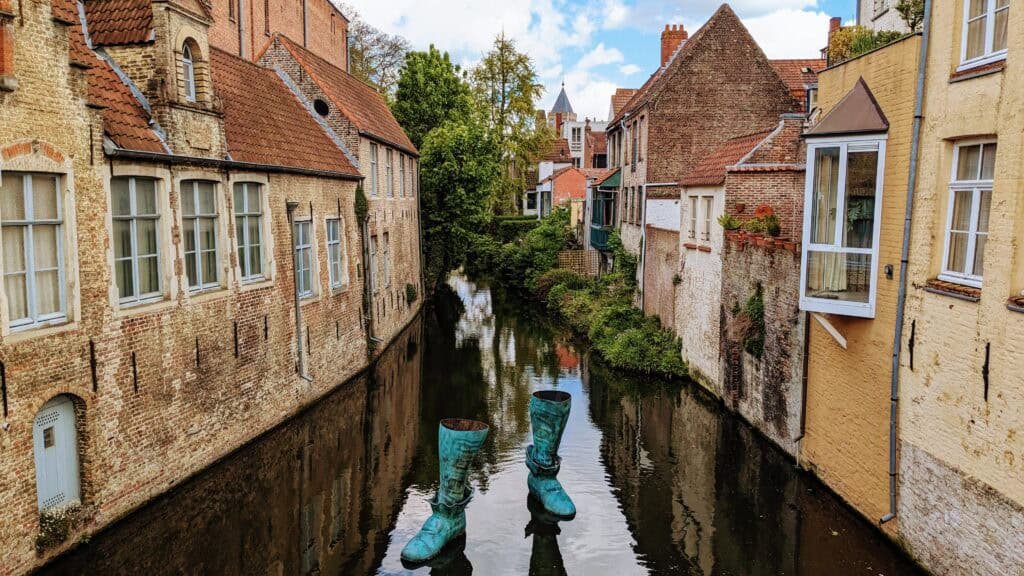
How can I be more sustainable when I visit Bruges?
Bruges is working hard to become more sustainable. Here’s how you can help:
- Use public transport or bike: It’s better for the environment and often quicker.
- Train, don’t fly: You’ll reduce your emissions getting to Bruges by up to 90%
- Stay in eco-friendly accommodation: Look for hotels with green certifications such as Green Key.
- Buy local: Support local artisans and businesses.
- Avoid single-use plastics: Bring a reusable water bottle and shopping bag.
- Spend your cash at local businesses: Bruges has a lot of cruise ship day trippers, which aren’t known to spend their cash (since they buy most things through the cruise ship company). Support local businesses and avoid chains.
For more eco-friendly travel tips, check out Visit Bruges’ sustainability page.
Frequently asked questions
Can you see Bruges in one day?
You can see the highlights in a day, but 2–3 days gives you time to relax and visit a museum or two without rushing.
Is Bruges walkable?
Yes – the historic centre is compact and best explored on foot. Bikes are useful for nearby suburbs but take care on cobbles.
Do museums close on Mondays?
Some do. Check each museum’s page before you plan a museum-heavy day (many are closed or have shorter hours on Mondays).
Conclusion
Bruges is one of the world’s most unique cities, from its picturesque canals to its quaint streets.
Bruges is a compact city made for slow travel: wander, sample a local beer, climb the Belfry at sunrise and save the museums for a weekday when they’re open.
⛪ Find out the best things to do in Bruges
⛪ Check the best areas to base yourself and the best hotels to stay in
⛪ Or, check out all our Belgium content
This page contains affiliate links. If you make a purchase through one of these links we make a small commission to help run this site, at no cost to you. Making a commission never affects the advice we give - see our content policy.

